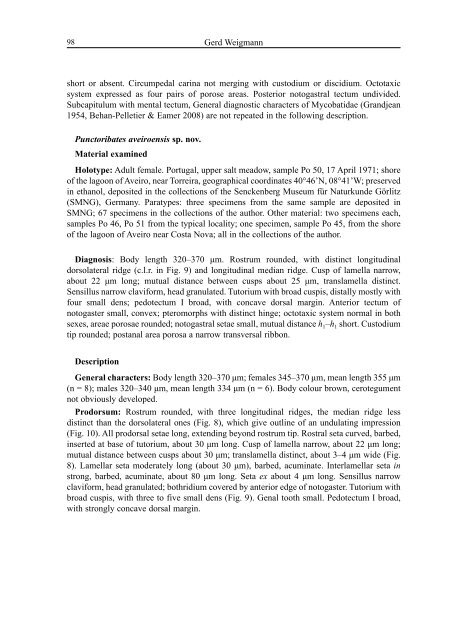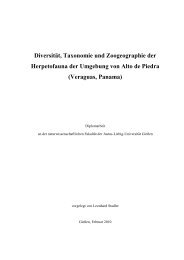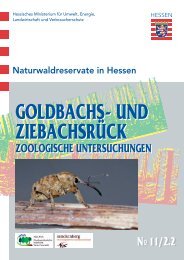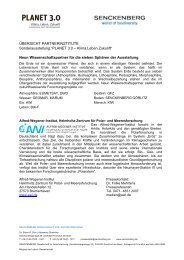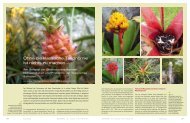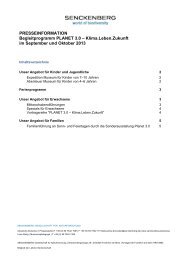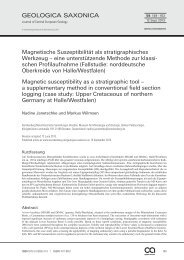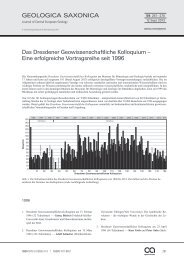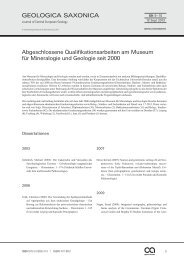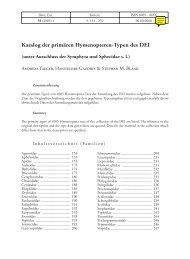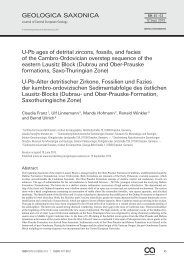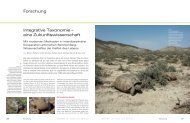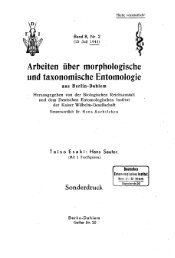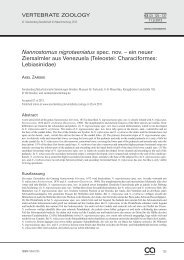Oribatid Mites (Acari: Oribatida) - Senckenberg
Oribatid Mites (Acari: Oribatida) - Senckenberg
Oribatid Mites (Acari: Oribatida) - Senckenberg
Create successful ePaper yourself
Turn your PDF publications into a flip-book with our unique Google optimized e-Paper software.
98<br />
Gerd Weigmann<br />
short or absent. Circumpedal carina not merging with custodium or discidium. Octotaxic<br />
system expressed as four pairs of porose areas. Posterior notogastral tectum undivided.<br />
Subcapitulum with mental tectum, General diagnostic characters of Mycobatidae (Grandjean<br />
1954, Behan-Pelletier & Eamer 2008) are not repeated in the following description.<br />
Punctoribates aveiroensis sp. nov.<br />
Material examined<br />
Holotype: Adult female. Portugal, upper salt meadow, sample Po 50, 17 April 1971; shore<br />
of the lagoon of Aveiro, near Torreira, geographical coordinates 40°46’N, 08°41’W; preserved<br />
in ethanol, deposited in the collections of the <strong>Senckenberg</strong> Museum für Naturkunde Görlitz<br />
(SMNG), Germany. Paratypes: three specimens from the same sample are deposited in<br />
SMNG; 67 specimens in the collections of the author. Other material: two specimens each,<br />
samples Po 46, Po 51 from the typical locality; one specimen, sample Po 45, from the shore<br />
of the lagoon of Aveiro near Costa Nova; all in the collections of the author.<br />
Diagnosis: Body length 320–370 µm. Rostrum rounded, with distinct longitudinal<br />
dorsolateral ridge (c.l.r. in Fig. 9) and longitudinal median ridge. Cusp of lamella narrow,<br />
about 22 µm long; mutual distance between cusps about 25 µm, translamella distinct.<br />
Sensillus narrow claviform, head granulated. Tutorium with broad cuspis, distally mostly with<br />
four small dens; pedotectum I broad, with concave dorsal margin. Anterior tectum of<br />
notogaster small, convex; pteromorphs with distinct hinge; octotaxic system normal in both<br />
sexes, areae porosae rounded; notogastral setae small, mutual distance h 1 –h 1 short. Custodium<br />
tip rounded; postanal area porosa a narrow transversal ribbon.<br />
Description<br />
General characters: Body length 320–370 µm; females 345–370 µm, mean length 355 µm<br />
(n = 8); males 320–340 µm, mean length 334 µm (n = 6). Body colour brown, cerotegument<br />
not obviously developed.<br />
Prodorsum: Rostrum rounded, with three longitudinal ridges, the median ridge less<br />
distinct than the dorsolateral ones (Fig. 8), which give outline of an undulating impression<br />
(Fig. 10). All prodorsal setae long, extending beyond rostrum tip. Rostral seta curved, barbed,<br />
inserted at base of tutorium, about 30 µm long. Cusp of lamella narrow, about 22 µm long;<br />
mutual distance between cusps about 30 µm; translamella distinct, about 3–4 µm wide (Fig.<br />
8). Lamellar seta moderately long (about 30 µm), barbed, acuminate. Interlamellar seta in<br />
strong, barbed, acuminate, about 80 µm long. Seta ex about 4 µm long. Sensillus narrow<br />
claviform, head granulated; bothridium covered by anterior edge of notogaster. Tutorium with<br />
broad cuspis, with three to five small dens (Fig. 9). Genal tooth small. Pedotectum I broad,<br />
with strongly concave dorsal margin.


